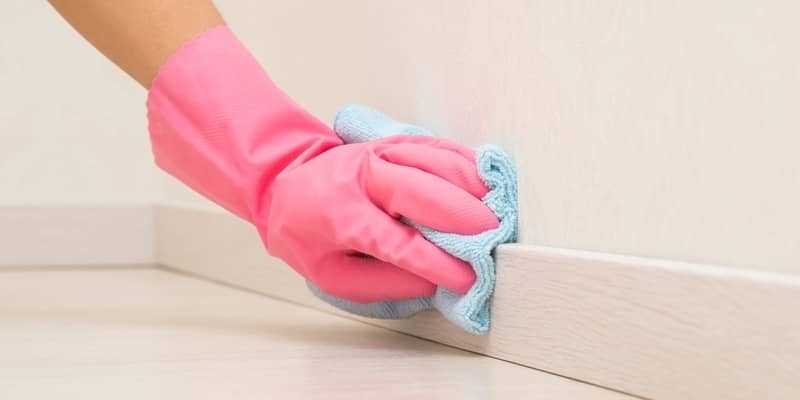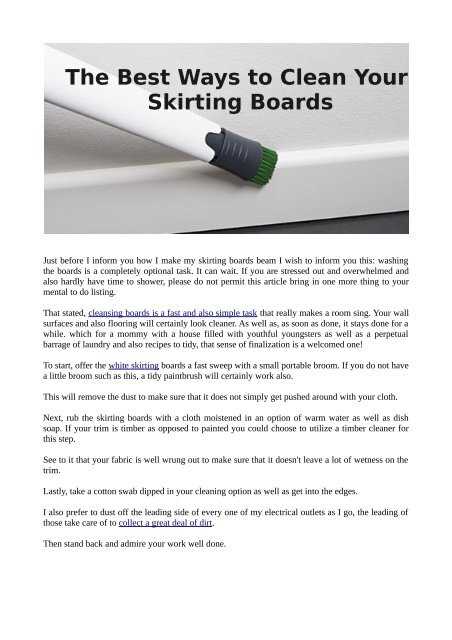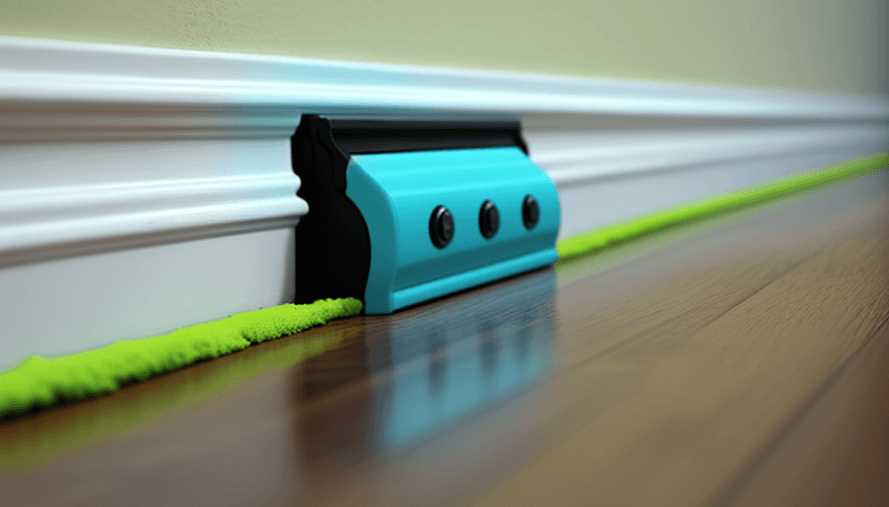




Cleaning skirting boards may not be the most glamorous task, but it is an essential part of maintaining a clean and tidy home. Skirting boards are notorious for collecting dust, dirt, and grime, and if left neglected, can become an eyesore. Luckily, cleaning skirting boards doesn’t have to be a difficult or time-consuming chore. With the right tools and techniques, you can easily keep your skirting boards looking pristine and enhance the overall appearance of your home.
1. Prepare your tools:
Before you begin cleaning your skirting boards, gather all the necessary tools. This includes a soft-bristle brush or vacuum cleaner with a dusting attachment, a damp cloth or sponge, a mild cleaning solution, and a bucket of warm water. Having everything prepared will make the cleaning process quicker and more efficient.
2. Dust with care:
The first step in cleaning skirting boards is to remove any loose dust and dirt. Use a soft-bristle brush or a vacuum cleaner with a dusting attachment to gently remove the debris. Start from the top and work your way down, making sure to pay attention to the corners and edges. Dusting regularly will prevent the build-up of dirt and make the cleaning process easier in the future.
3. Wipe with a damp cloth:
After you’ve dusted the skirting boards, it’s time to give them a thorough wipe-down. Dampen a cloth or sponge with a mild cleaning solution, such as a mixture of warm water and a small amount of dish soap. Make sure the cloth is not dripping wet, as excess water can damage the paint or wood. Wipe the skirting boards in a gentle, sweeping motion, making sure to remove any stains or marks. Repeat the process until the skirting boards are clean and free from dirt and grime.
4. Pay attention to details:
When cleaning skirting boards, it’s important to pay attention to the details. Use a toothbrush or cotton swab to clean hard-to-reach areas, such as the crevices between the skirting boards and the wall. These areas tend to accumulate dust and can be easily overlooked. Taking the time to thoroughly clean these areas will ensure that your skirting boards are spotless.
In conclusion, cleaning skirting boards is a task that should not be ignored. By following these expert tips, you can maintain clean and attractive skirting boards in your home. Regular maintenance and cleaning will not only enhance the appearance of your home but also contribute to a healthier living environment.
Effective Tools for Skirting Board Cleaning
When it comes to cleaning skirting boards, having the right tools can make the task much easier and more efficient. Here are some effective tools you can use to clean your skirting boards:
1. Soft-bristle brush
A soft-bristle brush is a versatile tool that can be used to gently sweep away dust and dirt from skirting boards. It is important to use a soft-bristle brush to prevent any damage or scratches to the surface of the skirting boards.
2. Microfiber cloth
A microfiber cloth is another essential tool for cleaning skirting boards. Its soft and gentle fibers easily attract and trap dust without leaving any residue behind. Dampen the cloth slightly with water or a cleaning solution to effectively remove any stubborn dirt or stains.
3. Vacuum cleaner with a brush attachment
A vacuum cleaner with a brush attachment is an efficient tool for removing loose dirt and dust from skirting boards. The brush attachment helps to agitate and loosen the dirt, allowing the vacuum cleaner to effectively suck it up.
4. Toothbrush

A toothbrush can be used to clean hard-to-reach corners and edges of skirting boards. Its small bristles can easily access narrow spaces and remove any accumulated dirt or grime.
5. Cleaning solution
Depending on the material of your skirting boards, you may need a cleaning solution to remove stubborn stains or grease. Dilute the cleaning solution according to the manufacturer’s instructions and apply it to the skirting boards with a cloth or sponge. Be sure to test the cleaning solution on a small, inconspicuous area first to ensure it does not cause any damage.
Remember, when using any tools or cleaning solutions on your skirting boards, it is important to be gentle and avoid applying excessive pressure to prevent any damage. Regularly cleaning your skirting boards will help maintain their appearance and prolong their lifespan.
Preparing the Skirting Boards for Cleaning
Before you start cleaning your skirting boards, it’s important to prepare them properly. This involves removing any loose or surface dirt, dust, or debris that may be present. Follow these steps to ensure your skirting boards are ready for a thorough clean:
- Gather your cleaning supplies: Before you begin, make sure you have all the necessary cleaning supplies. This may include a vacuum cleaner, microfiber cloths, a bucket of warm water, mild detergent, and a soft brush or toothbrush for hard-to-reach areas.
- Vacuum or dust: Use a vacuum cleaner with a soft brush attachment to remove any loose dirt, dust, or pet hair from the skirting boards. If you don’t have a vacuum cleaner, you can also use a dry microfiber cloth to gently wipe away the debris.
- Remove stubborn dirt: For any stubborn dirt or stains, you may need to use a damp cloth or sponge with mild detergent to gently scrub the affected areas. Be careful not to apply too much pressure or use abrasive cleaning tools that could damage the skirting boards.
- Pay attention to corners and grooves: Skirting boards often have corners, grooves, or decorative elements that can collect dust and dirt. Use a soft brush or toothbrush to clean these hard-to-reach areas and ensure all the dirt is removed.
- Protect the surrounding area: Before you start cleaning, it’s a good idea to protect the surrounding area to prevent any damage. You can use masking tape or plastic sheets to cover the floor or walls adjacent to the skirting boards.
By following these steps, you can ensure that your skirting boards are properly prepared for cleaning. This will help you achieve a more effective and thorough clean, leaving your skirting boards looking fresh and tidy.
Removing Dust and Dirt from Skirting Boards
Skirting boards are notorious for collecting dust and dirt, but with these simple tips, you can easily clean them and keep your home looking fresh and tidy.
1. Gather the necessary cleaning supplies
Before you start cleaning your skirting boards, gather the following supplies:
- Duster or microfiber cloth
- Vacuum cleaner with a brush attachment
- Mild detergent or cleaning solution
- Bucket of warm water
- Soft-bristle brush
- Old toothbrush
- Lint-free cloth
2. Dust the skirting boards
Start by dusting the skirting boards using a duster or microfiber cloth. Make sure to reach into the corners and crevices where dust tends to accumulate.
3. Vacuum the skirting boards
Next, use a vacuum cleaner with a brush attachment to remove any loose dirt or debris from the skirting boards. Move the brush attachment along the length of the skirting boards, applying gentle pressure to ensure a thorough clean.
4. Clean with a mild detergent solution
If there are stubborn stains or grime on the skirting boards, create a mild detergent solution by mixing a small amount of detergent with warm water in a bucket. Dip a soft-bristle brush into the solution and gently scrub the affected areas. Be careful not to use too much water, as excessive moisture can damage the skirting boards.
5. Scrub hard-to-reach areas
For hard-to-reach areas such as corners and grooves, use an old toothbrush dipped in the cleaning solution to scrub away any dirt or grime.
6. Rinse the skirting boards
After scrubbing, rinse the skirting boards with a clean cloth soaked in plain water to remove any leftover detergent residue.
7. Dry and polish the skirting boards
Finally, use a lint-free cloth to dry the skirting boards thoroughly. If desired, you can also polish the skirting boards with a furniture polish to give them a shiny finish.
By following these simple steps, you can easily remove dust and dirt from your skirting boards and keep them looking clean and well-maintained.
Tackling Stubborn Stains on Skirting Boards
Skirting boards are prone to accumulating stubborn stains over time. Whether it’s paint splatters, grease marks, or scuff marks, it’s important to tackle these stains promptly to keep your skirting boards looking clean and well-maintained. Here are some top tips on how to tackle stubborn stains on skirting boards:
1. Gather Your Cleaning Supplies
Before you start cleaning your skirting boards, gather all the necessary cleaning supplies. This may include:
- All-purpose cleaner
- Baking soda
- Vinegar
- Dish soap
- Microfiber cloth
- Soft-bristle brush
- Bucket of warm water
2. Identify the Type of Stain

Different stains require different cleaning methods. Identify the type of stain on your skirting board to determine the best approach. Common stains include:
- Paint: Use a scraper or a knife to gently scrape off the dried paint, taking care not to damage the surface of the skirting board.
- Grease: Mix dish soap with warm water and use a microfiber cloth to gently scrub the grease stain.
- Scuff marks: Create a paste using baking soda and water, then use a soft-bristle brush to gently scrub the scuff marks.
3. Test a Small Area
Before applying any cleaning solution to the entire skirting board, test it on a small, inconspicuous area to ensure it doesn’t damage or discolor the surface.
4. Clean the Stain
Once you’ve determined the best cleaning method for the stain, apply the appropriate cleaning solution and gently scrub the stain using a cloth or brush. Be sure to follow the manufacturer’s instructions for any cleaning products you use.
5. Rinse and Dry
After cleaning the stain, rinse the area with clean water to remove any residue. Then, dry the skirting board thoroughly with a clean cloth to prevent water damage or mold growth.
6. Regular Maintenance
To prevent stubborn stains from building up on your skirting boards, it’s important to do regular maintenance. Dusting the skirting boards regularly and wiping them down with a damp cloth can help prevent stains from setting in.
By following these tips, you can effectively tackle stubborn stains on your skirting boards and keep them looking clean and pristine.
Regular Maintenance and Preventive Measures for Skirting Boards
Skirting boards are an essential part of any room, not only for their aesthetic appeal but also for their protective function. To keep your skirting boards looking their best and to prolong their lifespan, regular maintenance and preventive measures are necessary. Here are some top tips to follow:
1. Regular dusting
Skirting boards can accumulate dust and dirt over time, so it’s important to dust them regularly. Use a soft cloth or a feather duster to gently remove the dust from the surface of the skirting boards. Avoid using abrasive materials or harsh chemicals that may damage the paint or finish.
2. Vacuuming
In addition to dusting, vacuuming your skirting boards can help remove any dirt or debris that may have settled in hard-to-reach areas. Use a brush attachment on your vacuum cleaner to carefully clean along the edges and corners of the skirting boards.
3. Wiping with a damp cloth
If your skirting boards have stains or marks that cannot be removed by dusting or vacuuming alone, you can wipe them with a damp cloth. Be sure to wring out the cloth well to avoid excessive moisture, as this can damage the skirting board material. For stubborn stains, you can use a mild detergent diluted in water, but test it in a small, inconspicuous area first to ensure it doesn’t cause any damage.
4. Avoiding excessive moisture
Skirting boards can be prone to damage from excessive moisture, especially in areas such as bathrooms or kitchens where there is a higher risk of spills or splashes. To prevent moisture damage, wipe up any spills or splashes immediately and ensure proper ventilation in the room to reduce condensation.
5. Regular inspections
Make it a habit to regularly inspect your skirting boards for any signs of damage, such as cracks, chips, or peeling paint. Promptly address any issues by repairing or repainting the affected areas to prevent further damage and maintain the overall appearance of your skirting boards.
6. Protective measures

To prevent accidental damage to your skirting boards, consider using protective measures such as corner guards or rubber bumpers. These can help protect the vulnerable edges and corners of the skirting boards from scratches, dents, and impact damage caused by furniture, vacuum cleaners, or foot traffic.
7. Professional cleaning
If your skirting boards have become heavily soiled or stained and regular cleaning methods are not sufficient, it may be beneficial to hire a professional cleaning service. They have the expertise and specialized tools to effectively clean and restore your skirting boards to their original condition.
By following these regular maintenance and preventive measures, you can ensure that your skirting boards remain clean, presentable, and in good condition for years to come.
FAQ
What are skirting boards?
Skirting boards, also known as baseboards or mopboards, are a type of decorative trim that is installed at the bottom of walls where they meet the floor. They serve both an aesthetic and functional purpose.
Why is it important to clean skirting boards?
Cleaning skirting boards is important for maintaining a clean and tidy home. Over time, dust, dirt, and grime can accumulate on skirting boards, making them look unsightly. Regular cleaning can help prevent the buildup of dirt and keep your skirting boards looking fresh.
How often should skirting boards be cleaned?
The frequency of cleaning skirting boards depends on the level of dirt and dust in your home. As a general rule, it is recommended to clean skirting boards at least once a month. However, if you have pets, allergies, or live in a particularly dusty environment, you may need to clean them more frequently.
What is the best way to clean skirting boards?
The best way to clean skirting boards is to start by dusting them with a dry microfiber cloth or duster to remove loose dirt and dust. Then, mix a solution of warm water and mild detergent and use a soft sponge or cloth to wipe down the skirting boards. Finally, rinse the area with clean water and dry with a towel.
Can I use vinegar to clean skirting boards?
Yes, you can use a solution of vinegar and water to clean skirting boards. Vinegar is a natural cleaner and can help remove dirt and grime. Mix equal parts of vinegar and water in a spray bottle, spray the solution onto the skirting boards, and wipe them clean with a cloth or sponge.
Are there any specialized tools or products for cleaning skirting boards?
While you can clean skirting boards with basic household items like a microfiber cloth and mild detergent, there are also specialized tools available that can make the task easier. For example, you can use a skirting board vacuum attachment or a long-handled skirting board brush to reach and clean all the nooks and crannies of your skirting boards.












